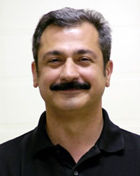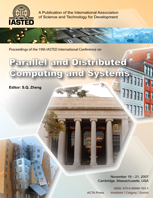The 23rd IASTED International Conference on
Parallel and Distributed Computing and Systems
PDCS 2011
December 14 – 16, 2011
Dallas, USA
KEYNOTE SPEAKER
A Reconfigurable Communication Topology
Abstract
Inherent limitations on the computational power of sequential uniprocessor systems have lead to the development of parallel multiprocessor systems. The two major issues in the formulation and design of parallel multiprocessor systems are algorithm design and architecture design. The parallel multiprocessor systems should be so designed so as to facilitate the design and implementation of the efficient parallel algorithms that exploit optimally the capabilities of the system. From an architectural point of view, the system should have low hardware complexity, be capable of being built of components that can be easily replicated, should exhibit desirable cost-performance characteristics, be cost effective and exhibit good scalability in terms of hardware complexity and cost with increasing problem size. In distributed memory multiprocessor systems, the processing elements can be considered to be nodes that are connected together via an interconnection network. In order to facilitate algorithm and architecture design, we require that the interconnection network have a low diameter, the system be symmetric and each node in the system have low degree of connectivity. Further, it is also desirable that the system configuration and behavior be amenable to a suitable and tractable mathematical description. The requirement of network symmetry ensures that each node in the network is identical to any other, thereby greatly reducing the architecture and algorithm design effort. For most symmetric network topologies, however, the requirements of low degree of connectivity for each node and low network diameter are often conflicting. Low network diameter often entails that each node in the network have a high degree of connectivity resulting in a drastic increase in the number of inter-processor connection links. A low degree of connectivity on the other hand, results in a high network diameter which in turn results in high inter-processor communication overhead and reduced efficiency of parallelism. Reconfigurable networks attempt to address this tradeoff. In a reconfigurable network each node has a fixed degree of connectivity irrespective of the network size. The network diameter is restricted by allowing the network to reconfigure itself into different configurations. In general, a reconfigurable system needs to satisfy the following criteria in order to be considered practically viable: (a) In each configuration the nodes in the network should have a fixed degree of active connectivity irrespective of network size, (b) The network diameter should be kept low via the reconfiguration mechanism and (c) The hardware for the reconfiguration mechanism (i.e. switch) should be of reasonable complexity. In this presentation, we discuss our design of a reconfigurable network topology that is targeted at medical applications; however, others have found a number of interesting properties about the network that makes it ideal for applications in computational biology as well as information engineering. We present some results and discuss our ongoing work in this area; time-permitting, we will also present a particular variation to our original reconfigurable network which is nature/biology inspired.Biography of the Keynote Speaker

Hamid R. Arabnia received a Ph.D. degree in Computer Science from the University of Kent (Canterbury, England) in 1987. In 1987, he worked as a Consultant for Caplin Cybernetics Corporation (London, England), where he helped in the design of a number of image processing algorithms that were targeted at a particular parallel machine architecture. Arabnia is currently a Full Professor of Computer Science at University of Georgia (Georgia, USA), where he has been since October 1987. His research interests include Parallel and distributed processing techniques and algorithms, interconnection networks, and applications (in particular, in image processing, medical imaging, bioinformatics, and other computational intensive problems). Dr. Arabnia is Editor-in-Chief of The Journal of Supercomputing (one of the oldest journals in Computer Science) published by Springer and is Associate Editor of IEEE Transactions on Information Technology in Biomedicine. He is also on the editorial and advisory boards of over 35 other journals. Dr. Arabnia is the recipient of William F. Rockwell, Jr. Medal for promotion of multi-disciplinary research (Rockwell Medal is International Technology Institute's highest honor). He has received a number of awards, including, The Johns Hopkins University National Search in recognition of his contributions to the national program for enhancing the quality of life for people with disabilities through the application of computing technology (signatories: co-directors of the National Search and President of Johns Hopkins U.) In 2006, he received the Distinguished Service Award in recognition and appreciation of his contributions to the profession of computer science and his assistance and support to students and scholars from all over the world; this award was presented to him on June 26, 2006 by Professor Barry Vercoe (Massachusetts Institute of Technology / MIT). More recently (October 14, 2007), Dr. Arabnia received an "Outstanding Achievement Award in Recognition of His Leadership and Outstanding Research Contributions to the Field of Supercomputing". This award was presented to him at Harvard University Medical School (signatories: Lawrence O. Hall, President of IEEE/SMC; Zhi-Pei Liang, Vice President of IEEE/EMB; Jack. Y. Yang, General Chair of IEEE BIBE and Harvard University; Mary Qu Yang, Chair of Steering Committee, IEEE BIBE and NIH). Dr. Arabnia is an elected Fellow, Int'l Society of Intelligent Biological Medicine (ISIBM) and is on the Advisory Board of IEEE Technical Committee on Scalable Computing (TCSC). He was recently nominated for Outstanding Service award by IEEE Computer Society Technical Committee on Parallel Processing (TCPP); Prof. Albert Zomaya won the award.
Dr. Arabnia has published extensively in journals and refereed conference proceedings. He has about 300 publications (journals, proceedings, editorship) in his area of research. He has been a PI/Co-PI on $7,139,525 externally funded projects/initiatives and on $103,453 internally funded projects (correct as of January 2009). He has also contributed projects for justification for equipment purchase (grant proposals worth over $4 Million - awarded). During his tenure as Graduate Coordinator/Director of Computer Science (August 2002 - January 2009), Dr. Arabnia secured the largest level of funding in the history of the department for supporting the research and education of graduate students (PhD, MS).
Dr. Arabnia has delivered numerous number of keynote lectures at international conferences; most recently at (since September 2008): The 14th IEEE International Conference on Parallel and Distributed Systems (ICPADS'08, Australia); International Conference on Future Generation Communication and Networking (FGCN 2008 / IEEE CS, Sanya); The 10th IEEE International Conference on High Performance Computing and Communications (HPCC-08, Dalian), … He has also delivered a number of "distinguished lectures" at various universities.


















